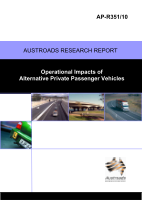Road Design

- Publication no: AP-R351-10
- ISBN: 978-1-921709-04-3
- Published: 1 February 2010
- PDF (free) Download
The motor car currently dominates personal travel. However its position is being challenged by concerns over congestion, fuel availability and price, local air quality and global atmospheric impacts. While public transport will be called on to play a greater role, particularly in urban areas, there is no evidence that it will be able to cater for the mobility needs of all urban residents. A business-as-usual scenario where independent motorised mobility continues to be achieved in vehicles like a current motor car is far from certain.
However, the desire for personal mobility continues to stimulate the creation of innovative vehicle designs. Increased diversity in the vehicle fleet has implications for road authorities in terms of road safety, driver training/licensing, road design (including parking lot design and lane configurations) and operational performance including accessibility, congestion and environmental impacts. Project NS1205 Operational Impacts of Alternative Vehicles, has been undertaken to provide Australia’s road authorities with enhanced understanding of the characteristics of emerging vehicle types, their potential impacts and their implications for changes which may be required in road design or regulations.
- SUMMARY
- 1. INTRODUCTION
- 1.1. Objectives and Scope of this Study
- 1.2. Structure of this Report
- 2. STUDY APPROACH AND METHODOLOGY
- 2.1. Overall Study Approach
- 2.2. Outcome Assessment Methodology
- 3. THE SPECTRUM OF ALTERNATIVE VEHICLES
- 3.1. Human Powered Vehicles
- 3.2. Hybrid Human and Motor Powered
- 3.3. Motor Powered
- 3.3.1. Personal Mobility Devices
- 3.3.2. Mopeds
- 3.3.3. Motorbikes and Motor Scooters
- 3.3.4. Three-wheel Cars
- 3.3.5. Microcars, Moped Cars and Neighbourhood Electric Vehicles
- 3.3.6. Conventional Motor Cars
- 4. FACTORS IMPACTING THE UPTAKE OF ALTERNATIVEVEHICLES
- 4.1. The Motor Car in Objective Terms
- 4.2. Forces and Enablers Likely to Increase the Uptake of AlternativePowered Personal Mobility Devices
- 4.2.1. Rising Fuel Prices
- 4.2.2. Road Congestion
- 4.2.3. Parking
- 4.2.4. The Vulnerability of Low Income Households
- 4.2.5. Changing Social Attitudes: Demographic Shifts and Perceptions of Climate Change
- 4.2.6. Climate Change Legislation
- 4.2.7. The Rise of the Car Sharing Industry
- 4.3. Forces Preventing an Increased Uptake of Alternative PoweredPersonal Mobility Devices
- 4.3.1. Availability
- 4.3.2. Vehicle Price and Functional Limitations
- 4.3.3. Broader Perceptions of the Car
- 4.3.4. Small Vehicle Safety
- 4.3.5. Road Legislation
- 4.3.6. Automotive Industry Inertia
- 4.4. Summary of Factors Impacting the Uptake of Alternative Vehicles
- 5. IMPACTS OF ALTERNATIVE VEHICLES ON KEYOUTCOMES
- 5.1. Personal Mobility Devices
- 5.1.1. Segway
- 5.1.2. Motorised Mobility Scooters (MMS)
- 5.2. Powered and Power Assisted Bicycles
- 5.2.1. Market Segments and Mobility Implications
- 5.2.2. Environmental Impacts
- 5.2.3. Safety Issues
- 5.2.4. Summary Assessment
- 5.3. Three-wheeled Cars/Enclosed Vehicles
- 5.3.1. Market Segments and Mobility Implications
- 5.3.2. Environmental Impacts
- 5.3.3. Safety Issues
- 5.3.4. Summary Assessment
- 5.4. Micro/Moped Cars
- 5.4.1. Market Segments and Mobility Implications
- 5.4.2. Environmental Impacts
- 5.4.3. Safety Issues
- 5.4.4. Summary Assessment
- 5.5. Assessment Summary
- 6. IMPLICATIONS AND PRIORITIES
- 6.1. Broad Responses
- 6.2. Regulatory Implications
- 6.3. Geometric Design
- 6.4. Priorities
- 7. CONCLUSIONS
- REFERENCES
